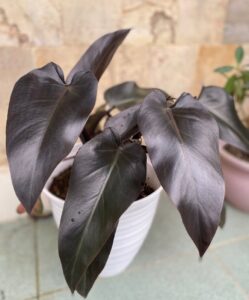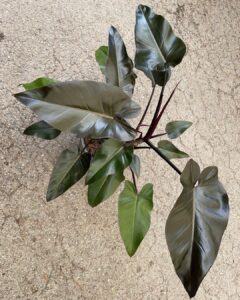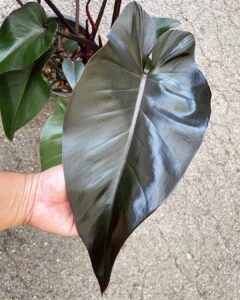Explore the Black Majesty Philodendron Care and Growing Guide for bringing an elegant, bold vibe to your indoor garden.
Check out this Black Majesty Philodendron Care and Growing Guide and learn the ins and outs of nurturing this plant. Elevate your indoor gardening with this essential resource.
Check out Philodendron Orange Marmalade Care and Growing Guide
Black Majesty Philodendron Information

The Philodendron Black Majesty is commonly known as a self-heading philodendron. It inherits its noteworthy characteristics from both the Philodendron Verrucosum L.Mathieu ex Schott and Philodendron Sodiroi. This plant is perennial, growing as a vine, and it’s a type of aroid found in the Araceae family.
The Philodendron Majesty stands out as a unique dark-black glossy leaf hybrid within the Philodendron family. While the specific hybridizer remains unknown, it was given the name by Neil Crafter and has gained global popularity among plant enthusiasts.
Check Tips for Growing Strawberry Shake Philodendron
How to Propagate Philodendron Black Majesty

Propagation from Divisions:
- Choose a healthy Philodendron Black Majesty and water it a day or two before propagating.
- Gather a clean knife/shear, well-draining soil, pots, and optional rooting hormone.
- Look for areas with multiple stems emerging from the soil for division.
- Gently remove the plant from its pot, shaking off excess soil to see the roots.
- Use a clean tool to split the plant into sections with roots and stems.
- Place each section in its pot with well-draining soil. Pat soil around the base.
- Water divisions thoroughly; place pots in bright, indirect light.
- Watch for new leaves and shoots as signs of successful propagation.
- Gently tug divisions after a few weeks to see if they’ve rooted.
- Move the divisions to larger pots as they grow.
Propagation from Cuttings
- Choose a healthy Philodendron Black Majesty plant with well-developed stems and leaves. The plant should be free from diseases or pests.
- Look for a stem that is at least a few inches long and has a few nodes (small bumps where leaves and roots grow). Nodes are essential for root development.
- Using the scissors or shears, make a clean cut just below a node on the chosen stem. This is where the roots will form.
- Trim away any leaves near the bottom of the cutting, leaving a few leaves at the top intact. This reduces moisture loss and directs energy toward root growth.
- If you prefer to root the cutting in water first, place the cutting in a container with enough water to cover the nodes. Change the water every few days to prevent stagnation.
- Once the cutting develops roots (usually after a few weeks), you can plant it in well-draining soil.
- Make a small hole in the soil, insert the rooted cutting, and gently pat the soil around it.
- Cover the newly planted cutting with a plastic bag or a clear plastic dome to create a humid environment. This helps prevent excessive moisture loss.
- Place the potted cutting in a spot with bright, indirect light. Avoid direct sunlight, as it can be too intense for the young plant.
- Water the cutting sparingly to keep the soil slightly moist but not soggy. Mist the plant occasionally to maintain humidity.
- When the cutting has established a good root system and is growing well, you can consider transplanting it into a larger pot with regular philodendron care.
Best Pot Size for Growing Black Majesty Philodendron
What type of pot should you choose for your Black Majesty Philodendron? Opt for a 5-inch pot, or consider a hanging basket suspended from the ceiling. This is because this indoor plant prefers its roots to be crowded.
Check Philodendron Fuzzy Petiole Growing and Care Guide
Ideal Growing Conditions for Black Majesty Philodendron

Location
Place your Black Majesty Philodendron where it receives bright, indirect light. It prospers when placed in an east or north-facing window where it can get filtered sunlight. Avoiding direct sun exposure is crucial to prevent leaf damage.
Soil
The ideal soil for Black Majesty Philodendron is well-draining and enriched with organic matter. A blend of peat-based potting soil, perlite, and sphagnum moss provides good drainage and moisture retention.
Water
Keep the soil consistently moist but not waterlogged. Water when the top inch of soil is dry, ensuring proper drainage. Adjust watering frequency according to the season, more during growth and slightly less in dormancy.
Avoid letting the plant completely dry out. Monitoring soil moisture is key to maintaining the plant’s health.
Temperature and Humidity
To ensure Black Majesty Philodendron’s well-being, avoid exposing it to extended cold periods. Maintain temperatures between 55 and 90 Fahrenheit. Keep evening temperatures at 65-70 F and daytime temperatures between 75-85 F.
Just like other tropical plants, it flourishes in elevated humidity, ideally ranging from 40% to 80%. Boost moisture by occasionally misting the plant. Alternatively, consider using a humidifier to uphold the right humidity levels.
Check Shampoo Ginger Lily Plant Growing and Care Guide
Black Majesty Philodendron Care

Fertilizer
For Black Majesty Philodendron, use a balanced, water-soluble fertilizer with a 20-20-20 ratio or similar. Apply every 4-6 weeks during the growing season, diluting to half-strength. Pause or reduce fertilization in fall and winter. Follow the manufacturer’s guidelines and observe the plant’s response to ensure successful fertilization without overdoing it.
Pruning
Prune Black Majesty Philodendron to remove dead or yellow leaves, encourage bushier growth by trimming leggy stems, and eliminate damaged or diseased parts. Regular checks for pests and diseases are important. Pruning can be done as needed throughout the year using clean, sharp tools.
Repotting
Repot Black Majesty Philodendron when its roots are popping out from the drainage holes of the planter. Select a pot 2 inches bigger than the existing one. You can do repotting in late winter or spring.
Pests and Diseases
Pests:
Spider Mites: These tiny insects can create fine webs on leaves and cause discoloration.
Mealybugs: Small, white insects with a cotton-like appearance that often gather in leaf axils and crevices.
Aphids: Small, soft-bodied insects that can cluster on new growth, causing distortion and sap-sucking damage.
Scale Insects: These pests can look like bumps on leaves and stems and can weaken the plant.
Diseases:
Leaf Spot: Fungal or bacterial infections that cause dark, irregular spots on leaves.
Root Rot: Caused by overwatering or poorly draining soil, it affects the roots and can lead to wilting and decline.
Powdery Mildew: A white, powdery growth on leaves caused by fungal infection.
Bacterial Blight: This leads to black or brown spots on leaves and can spread quickly.
Prevention and Management:
- Regularly inspect your plant for signs of pests or diseases.
- Isolate new plants for a few weeks to prevent introducing pests.
- Maintain proper watering practices to prevent root rot.
- Provide good air circulation to discourage fungal growth.
- If pests or diseases are detected, consider using insecticidal soap. You can also use neem oil for pests and appropriate fungicides for fungal issues.
Learn Growing Hoya Caudata Sumatra
Toxicity
Philodendron Black Majesty is toxic to humans, cats, and dogs. It contains calcium oxalate, which can cause skin irritation and swelling upon contact. Ingestion of the plant can lead to more serious symptoms such as breathing difficulty and throat swelling. If you suspect ingestion, seek medical help urgently.



